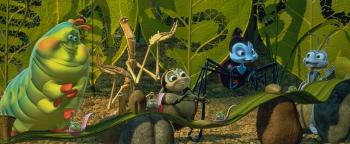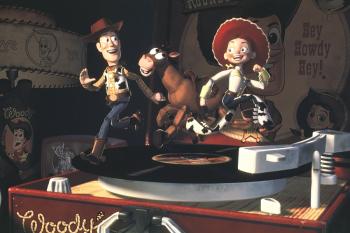The Fabulous Disney Babe
Page 3 of 4

For A Bug's Life, they started to study bugs and figured that, using RenderMan, they could bump the plastic surfaces up a level, as bugs were kind of like lobsters, with exoskeletons, and some were interestingly iridescent. In Toy Story, all of the surfaces were inorganic and pretty much flat. Now, they had to tackle organic surfaces. To tackle this new challenge, they experimented with multiple lenses.
Their friends at Disney got to go to Africa to prepare for The Lion King and to China for Mulan. The A Bug's Life group went on a field study too: out to the planters in front of Pixar. These "great geeks" made a tiny video camera on a stick with Lego wheels and sent it into the planters. From there, grass looks like Sequoias, a leaf like the Staples Center, (the huge arena and convention center in Los Angeles ~Fab) they also made a new discovery: everything is translucent from down there. Like a stained glass window, the light filters through the leaves.
To tell a good story, you have to take things that are familiar to every single person in the audience, like the brother who ripped Barbie's head off. "Come on, we all know what Barbie's neck looks like! And if you give Barbie a haircut, she looks like hell!" For A Bug's Life, it was things like dandelions - kids love to blow on them; to an ant, they could be like a hang-glider.
While they were on A Bug's Life, they started developing Toy Story 2, which was to go direct-to-video. The story would focus on the most tragic thing that could happen to a toy: being outgrown. John's 5 sons love to come to his work and play with the toys there. "It's like, I love my sons, but...I put the okay stuff down low." the Woody signed by Tom Hanks stays up high, out of reach.
At this point, John's mic went out and he yelled until the problem was fixed.
On the shelf, it would never be played with. The beautiful thing about Toy Story was that there was no backstory for Woody. They could create one for Toy Story 2, and that was that Woody was a highly collectible toy. The staging and direction for computer animation is wildly different from that of traditional animation; Lee Unkrich out of USC film school, who co-directed both of the Toy Story films, A Bug's Life and Monsters, Inc., staged the films similar to live-action, which kept the technology from distracting from the story.
They had so much fun doing research with collectors. They talked to Hopalong Cassidy collectors and Howdy Doody collectors, studying the kinds of merchandise created in that time, what kind of packaging was used, and how they aged. From a character's point of view, they figured out how a toy would feel to be packed away, and this led to John discussing the Pixar character of whom he is most proud: Jessie, the Yodeling Cowgirl.

(Jessie was originally Senorita Cactus, who served pretty much as a sidekick for Prospector ~Fab) John's wife warned him, when they were working on Toy Story 2: "You'd better make some characters for girls!" What about the girls? There were many strong women at Pixar, who control the budgets and stuff, so John thought this might be a good idea. She'd be a tragic character, a toy who's been outgrown, but to even out her character, he made her intro as crazy as possible. She is so excited to be "rescued" from storage, nuts over the fact that she's going to be seen by lots of kids. She turns on a dime, however, and hates Woody for not going. (Also note in the film her fear of returning to the box, when Prospector has to promise her it won't be forever to get her to comply ~Fab) Just as Woody is preparing to leave, the Prospector suggests he talk to Jessie.
